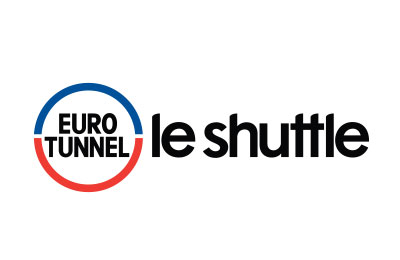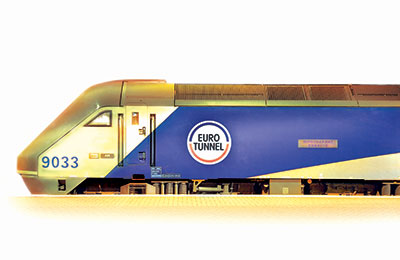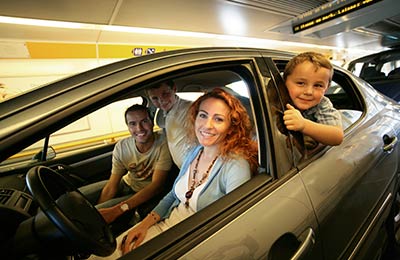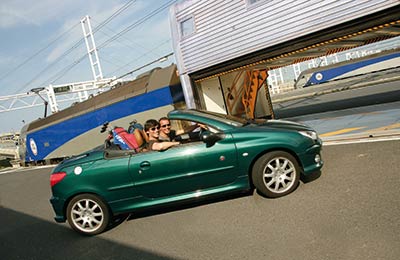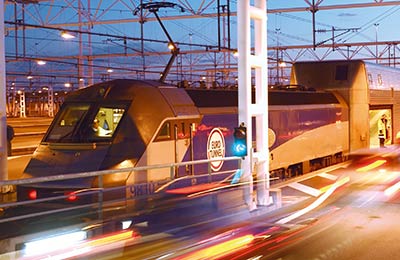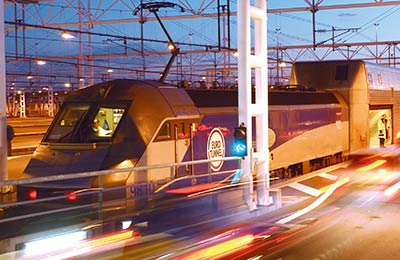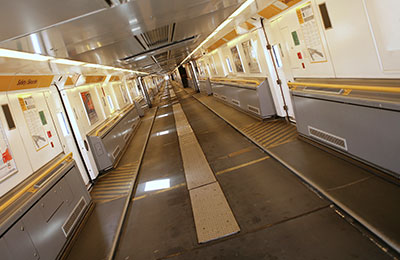Eurotunnel
Book Here
Eurotunnel "Le Shuttle" is ideal for a quick hop across the English Channel.
Book Eurotunnel today with eurodrive.co.uk – Eurotunnel route from Folkestone to Calais available to book.
Eurotunnel underground trains operate under the highest safety and security measures and aim to provide one of the fastest and most effortless ways of reaching Europe from the UK. Up to 53 channel crossings daily and a crossing time of 35 minutes make the Le Shuttle Eurotunnel service the fastest route to Calais. Travelling the 31 miles across the Channel cannot be done any faster than this. Looking for an alternative to a Ferry to France? Go via the Channel Tunnel.
Eurotunnel - Routes
| Timetables | Number of Crossings | Duration |
|---|---|---|
| Folkestone - Calais | up to 76 per Day | approx. 35 mins |
| Calais - Folkestone | up to 72 per Day | approx. 35 mins |
Eurotunnel - Find out more
Eurotunnel - Ports
Eurotunnel - Pet Booking Information
To travel abroad with your pet, you will require a Pet Passport.
You can take your cat or dog on your Eurotunnel crossings. When you select your preferred route, simply select the number of dogs or cats that you are travelling with. If the option is not available, please contact us.
More About Eurotunnel
Eurotunnel is a market leader for cross-channel travel between the UK and continental Europe. Since the Channel Tunnel opened in year 1994, Eurotunnel has captured around 60% of the short-sea market. The Channel Tunnel is 50km long, with the 39km undersea section being the longest undersea tunnel in the world. Eurotunnel offers up to 53 crossings per day using the highest safety & security measures. Eurotunnel locomotives are the most powerful locomotives in the world. Generating up to 7MW (7500hp) they haul trains of up to 2,400 tones at speeds of up to 140kph. 112 million people travelled through the Channel Tunnel on Eurotunnel passenger shuttle services between when it opened in 1994 until 2000. Eurotunnel is also the market leader for pet travel, with some 50,000 dogs and cats have crossing the Channel Eurotunnel in the period between February 2000 and June 2002, thanks to the Pet Travel Scheme.
The opening of the Channel Tunnel in 1994 turned a centuries old dream of a fixed link between the UK and mainland Europe into reality. 13,000 years earlier Britain was still connected to mainland Europe by a natural isthmus. Idea of the Channel Tunnel and Eurotunnel started in 1802 when Albert Mathieu, French mining engineer, developed the first ever design for a Channel Tunnel. In 1803, Henry Mottray, an English designer, followed Albert's work. However, it was only following the advent of steam trains and the construction of the rail network in Britain after 1830, some 30 years later, that led to the first proposals for a rail tunnel between France and England. By the mid 19th century, French mining engineer, Thomé de Gamond had spent 30 years working on seven different designs for the Channel Tunnel. It was in 1880 when the Beaumont & English tunnel-boring machine began digging undersea tunnels on both sides of the Channel that the first attempt at a tunnel excavation began. The idea of the Channel Tunnel and a fixed link continued to challenge the minds of French and English engineers for over 60 years, between the 1880s and 1945, but none of projects took off and they all remained firmly on the drawing board.
In 1955, the British Defence Minister announced that he no longer opposed a fixed link on military ground, and, finally, in 1957 a Channel Tunnel Study Group was formed. In 1960, the group proposed a railway tunnel system comprising two main tunnels and a service tunnel. The project of building the Channel Tunnel was formally launched in 1973. However, the project was abandoned a couple of years later due to the fuel crisis. On 30 November 1984, British and French Government announced their intention to seek private promoters for the construction and operation of a fixed link without public funding. The invitation to tender was issued in March 1985 and four serious proposals were submitted by 31 October 1985. On 20 January 1986, Margaret Thatcher and François Mitterrand announced that the bid for construction of the Channel Tunnel had been selected. Three weeks later on 12 February 1986 the foreign ministers of both countries signed the Franco-British Treaty in Canterbury. On 14 March, the Concession was awarded, granting the two concessionaires "jointly and severally...the right and the obligation to carry out the development, financing, construction and operation" of the tunnel. On 29 July 1987 Margaret Thatcher and François Mitterrand ratified the Fixed Link Treaty, paving the way for the Channel Tunnel to become a reality.
The Channel Tunnel truly represents the biggest ever infrastructure project in Europe. Eurotunnel manages the infrastructure of the Channel Tunnel and operates accompanied truck shuttle and passenger shuttle (car and coach) services between Folkestone, UK and Coquelles, France. Eurotunnel also earns toll revenue from other train operators (Eurostar for rail passengers, and EWS and SNCF for rail freight), which use the Tunnel. Eurotunnel is quoted on the London, Paris and Brussels Stock Exchanges. In accordance with the Concession to operate the Channel Tunnel, Eurotunnel has submitted a proposal for a second Channel Tunnel.
In May 2004, Eurotunnel scooped The Best Train Company Award at The Guardian and Observer Travel Awards 2004. It was a convincing win for Eurotunnel with 74.6% online votes and the organisers said: "The best way to take a train, it seems, is to drive your car on and head underwater."
In 2016, some 2.6 million passenger vehicles were transported by Eurotunnel, carrying an estimated 10.5 million people across the English Channel.
